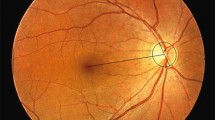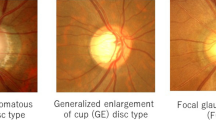Abstract
Purpose
To study the characteristics of patients with advanced open-angle glaucoma.
Methods
A hospital-based retrospective study was performed. Advanced glaucoma was defined as visual acuity of 0.3 or less, or mean deviation of −24 dB or less. First, we screened patients with advanced glaucoma and classified their glaucoma types. For patients with open-angle glaucoma (OAG), including both primary open-angle glaucoma (POAG) and normal-tension glaucoma (NTG), disc types were classified into four groups: focal ischemic (FI), myopic glaucomatous (MY), senile sclerotic (SS), and generalized cup enlargement (GE).
Results
After checking the medical history of 750 glaucoma patients, we classified 141 (18.8%) as having the advanced stage of the disease. The proportion of patients with advanced OAG was 47% (28% POAG, 19% NTG). The classification of optic disc appearances in OAG patients showed that in patients with POAG the predominant disc type was GE (P = 0.0012) and in those with NTG it was MY (P < 0.0001).
Conclusion
In OAG patients in this study with severe glaucomatous damage, the predominant disc phenotype was GE in patients with POAG and MY in those with NTG.
Similar content being viewed by others
References
Quigley HA. Number of people with glaucoma worldwide. Br J Ophthalmol 1996;80:389–393.
The effectiveness of intraocular pressure reduction in the treatment of normal-tension glaucoma. Collaborative Normal-Tension Glaucoma Study Group. Am J Ophthalmol 1998;126:498–505.
Heijl A, Leske MC, Bengtsson B, Hyman L, Hussein M. Reduction of intraocular pressure and glaucoma progression: results from the Early Manifest Glaucoma Trial. Arch Ophthalmol 2002;120:1268–1279.
Kass MA, Heuer DK, Higginbotham EJ, et al. The Ocular Hypertension Treatment Study: a randomized trial determines that topical ocular hypotensive medication delays or prevents the onset of primary open-angle glaucoma. Arch Ophthalmol 2002;120:701–713; discussion 829–730.
Iwase A, Suzuki Y, Araie M, et al. The prevalence of primary openangle glaucoma in Japanese: the Tajimi Study. Ophthalmology 2004;111:1641–1648.
Geijssen HC, Greve EL. Vascular concepts in glaucoma. Curr Opin Ophthalmol 1995;6:71–77.
Nicolela MT, Drance SM. Various glaucomatous optic nerve appearances: clinical correlations. Ophthalmology 1996;103:640–649.
Anderson DR, Drance SM, Schulzer M. Natural history of normaltension glaucoma. Ophthalmology 2001;108:247–253.
Hart WM Jr, Yablonski M, Kass MA, Becker B. Multivariate analysis of the risk of glaucomatous visual field loss. Arch Ophthalmol 1979;97:1455–1458.
Armaly MF, Krueger DE, Maunder L, et al. Biostatistical analysis of the collaborative glaucoma study. I. Summary report of the risk factors for glaucomatous visual-field defects. Arch Ophthalmol 1980;98:2163–2171.
Yablonski ME, Zimmerman TJ, Kass MA, Becker B. Prognostic significance of optic disk cupping in ocular hypertensive patients. Am J Ophthalmol 1980;89:585–592.
Gordon MO, Beiser JA, Brandt JD, et al. The Ocular Hypertension Treatment Study: baseline factors that predict the onset of primary open-angle glaucoma. Arch Ophthalmol 2002;120:714–720; discussion 829–730.
Sawada A, Tomidokoro A, Araie M, Iwase A, Yamamoto T. Refractive errors in an elderly Japanese population: the Tajimi study. Ophthalmology 2008;115:363–370.e3.
Sperduto RD, Seigel D, Roberts J, Rowland M. Prevalence of myopia in the United States. Arch Ophthalmol 1983;101:405–407.
Kempen JH, Mitchell P, Lee KE, et al. The prevalence of refractive errors among adults in the United States, Western Europe, and Australia. Arch Ophthalmol 2004;122:495–505.
Podos SM, Becker B, Morton WR. High myopia and primary openangle glaucoma. Am J Ophthalmol 1966;62:1038–1043.
Perkins ES, Phelps CD. Open angle glaucoma, ocular hypertension, low-tension glaucoma, and refraction. Arch Ophthalmol 1982;100:1464–1467.
Fong DS, Epstein DL, Allingham RR. Glaucoma and myopia: are they related? Int Ophthalmol Clin 1990;30:215–218.
Wilson MR, Hertzmark E, Walker AM, Childs-Shaw K, Epstein DL. A case-control study of risk factors in open angle glaucoma. Arch Ophthalmol 1987;105:1066–1071.
Mitchell P, Hourihan F, Sandbach J, Wang JJ. The relationship between glaucoma and myopia: the Blue Mountains Eye Study. Ophthalmology 1999;106:2010–2015.
Wong TY, Klein BE, Klein R, Knudtson M, Lee KE. Refractive errors, intraocular pressure, and glaucoma in a white population. Ophthalmology 2003;110:211–217.
Phelps CD. Effect of myopia on prognosis in treated primary openangle glaucoma. Am J Ophthalmol 1982;93:622–628.
Chihara E, Liu X, Dong J, et al. Severe myopia as a risk factor for progressive visual field loss in primary open-angle glaucoma. Ophthalmologica 1997;211:66–71.
Author information
Authors and Affiliations
Corresponding author
About this article
Cite this article
Nakazawa, T., Fuse, N., Omodaka, K. et al. Different types of optic disc shape in patients with advanced open-angle glaucoma. Jpn J Ophthalmol 54, 291–295 (2010). https://doi.org/10.1007/s10384-010-0816-y
Received:
Accepted:
Published:
Issue Date:
DOI: https://doi.org/10.1007/s10384-010-0816-y




